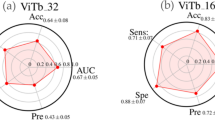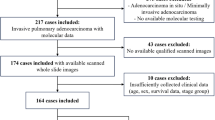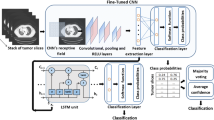Abstract
Purpose
Although surgery is the primary treatment for lung cancer, some patients experience recurrence at a certain rate. If postoperative recurrence can be predicted early before treatment is initiated, it may be possible to provide individualized treatment for patients. Thus, in this study, we propose a computer-aided diagnosis (CAD) system that predicts postoperative recurrence from computed tomography (CT) images acquired before surgery in patients with lung adenocarcinoma using a deep convolutional neural network (DCNN).
Methods
This retrospective study included 150 patients who underwent curative surgery for primary lung adenocarcinoma. To create original images, the tumor part was cropped from the preoperative contrast-enhanced CT images. The number of input images to the DCNN was increased to 3000 using data augmentation. We constructed a CAD system by transfer learning using a pretrained VGG19 model. Tenfold cross-validation was performed five times. Cases with an average identification rate of 0.5 or higher were determined to be a recurrence.
Results
The median duration of follow-up was 73.2 months. The results of the performance evaluation showed that the sensitivity, specificity, and accuracy of the proposed method were 0.75, 0.87, and 0.82, respectively. The area under the receiver operating characteristic curve was 0.86.
Conclusion
We demonstrated the usefulness of DCNN in predicting postoperative recurrence of lung adenocarcinoma using preoperative CT images. Because our proposed method uses only CT images, we believe that it has the advantage of being able to assess postoperative recurrence on an individual patient basis, both preoperatively and noninvasively.








Similar content being viewed by others
Code and data availability
The code generated in this study is available from the corresponding author on reasonable request. However, the image datasets presented in this study are not publicly available due to ethical reasons.
References
Hirsch FR, Scagliotti GV, Mulshine JL, Kwon R, Curran WJ Jr, Wu Y-L, Paz-Ares L (2017) Lung cancer: current therapies and new targeted treatments. Lancet 389:299–311. https://doi.org/10.1016/S0140-6736(16)30958-8
Sawabata N, Asamura H, Goya T, Mori M, Nakanishi K, Eguchi K, Koshiishi Y, Okumura M, Miyaoka E, Fujii Y, Japanese Joint Committee for Lung Cancer Registry (2010) Japanese lung cancer registy study: first prospective enrollment of a large number of surgical and nonsurgical cases in 2002. J Thorac Oncol 5:1369–1375. https://doi.org/10.1097/JTO.0b013e3181e452b9
The Japan Lung Cancer Society (2020) Guidelines for diagnosis and treatment of the lung cancer/malignant pleural mesothelioma/thymic tumors. Kanehara & Co.,Ltd. https://www.haigan.gr.jp/modules/guideline/index.php?content_id=3. Accessed 10 April 2020
Asamura H, Goya T, Koshiishi Y, Sohara Y, Eguchi K, Mori M, Nakanishi Y, Tsuchiya R, Shimokata R, Shimokata K, Inoue H, Nukiwa T, Miyaoka E, Japanese Joint Committee for Lung Cancer Registry (2008) A Japanese lung cancer registry study: prognosis of 13,010 resected lung cancers. J Thorac Oncol 3:46–52. https://doi.org/10.1097/JTO.0b013e31815e8577
Okami J, Shintani Y, Okumura M, Ito H, Ohtsuka T, Toyooka S, Mori T, Watanabe SI, Date H, Yokoi K, Asamura H, Nagayasu T, Miyaoka E, Yoshiono I, Japanese Joint Committee for Lung Cancer Registry (2019) Demographics, safety and quality, and prognostic information in both the seventh and eighth editions of the TNM classification in 18,973 surgical cases of the Japanese joint committee of lung cancer registry database in 2010. J Thorac Oncol 14:212–222. https://doi.org/10.1016/j.jtho.2018.10.002
Goldstraw P, Chansky K, Crowley J, Rami-Porta R, Asamura H, Eberhardt WE, Nicholson AG, Groome P, Mitchell A, Bolejack V, International Association for the Study of Lung Cancer Staging and Prognostic Factors Committee, Advisory Boards, and Participating Institutions (2016) The IASLC Lung Cancer Staging Project: proposals for revision of the TNM stage groupings in the forthcoming (eighth) edition of the TNM classification for lung cancer. J Thorac Oncol 11:39–51. https://doi.org/10.1016/j.jtho.2015.09.009
Carnio S, Novello S, Papotti M, Loiacono M, Scagliotti GV (2013) Prognostic and predictive biomarkers in early stage non-small cell lung cancer: tumor based approaches including gene signatures. Transl Lung Cancer Res 2:372–381. https://doi.org/10.3978/j.issn.2218-6751.2013.10.05
Fedor D, Johnson WR, Singhal S (2013) Local recurrence following lung cancer surgery: incidence, risk factors, and outcomes. Surg Oncol 22:156–161. https://doi.org/10.1016/j.suronc.2013.04.002
Maeda R, Yoshida J, Ishii G, Hishida T, Nishimura M, Nagai K (2011) Risk factors for tumor recurrence in patients with early-stage (stage I and II) non-small cell lung cancer: patient selection criteria for adjuvant chemotherapy according to the seventh edition TNM classification. Chest 140:1494–1502. https://doi.org/10.1378/chest.10-3279
Shimada Y, Saji H, Yoshida K, Kakihana M, Honda H, Nomura M, Usuda J, Kajiwara N, Ohira T, Ikeda N (2012) Pathological vascular invasion and tumor differentiation predict cancer recurrence in stage IA non-small-cell lung cancer after complete surgical resection. J Thorac Oncol 7:1263–1270. https://doi.org/10.1097/JTO.0b013e31825cca6e
Sawada S, Yamashita N, Suehisa H, Yamashita M (2013) Risk factors for recurrence after lung cancer resection as estimated using the survival tree method. Chest 144:1238–1244. https://doi.org/10.1378/chest.12-3034
Aramini B, Casali C, Stefani A, Bettelli S, Wagner S, Sangale Z, Hughes E, Lanchbury JS, Maiorana A, Morandi U (2016) Prediction of distant recurrence in resected stage I and II lung adenocarcinoma. Lung Cancer 101:82–87. https://doi.org/10.1016/j.lungcan.2016.09.005
Koo HJ, Xu H, Choi CM, Song JS, Kim HR, Lee JB, Kim KY (2016) Preoperative CT predicting recurrence of surgically resected adenocarcinoma of the lung. Medicine 95:e2513. https://doi.org/10.1097/MD.0000000000002513
Matsuguma H, Nakahara R, Igarashi S, Ishikawa Y, Suzuki H, Miyakawa N, Honjo S, Yokoi K (2008) Pathologic stage I non-small cell Lung cancer with high levels of preoperative serum carcinoembryonic antigen: clinicopathologic characteristics and prognosis. J Thorac Cardiovasc Surg 135:44–49. https://doi.org/10.1016/j.jtcvs.2007.09.032
Yamazaki M, Ishikawa H, Kunii R, Tasaki A, Sato S, Ikeda Y, Yoshimura N, Hashimoto T, Tsuchida M, Aoyama H (2015) A combination of preoperative CT findings and postoperative serum CEA levels improves recurrence prediction for stage I lung adenocarcinoma. Eur J Radiol 84:178–184. https://doi.org/10.1016/j.ejrad.2014.10.009
Lee ES, Son DS, Kim SH, Lee J, Jo J, Han J, Kim H, Lee HJ, Choi HY, Jung Y, Park M, Lim YS, Kim K, Shim Y, Kim BC, Lee K, Huh N, Ko C, Park K, Lee JW, Ys C, Kim J (2008) Prediction of recurrence-free survival in postoperative non-small cell lung cancer patients by using an integrated model of clinical information and gene expression. Clin Cancer Res 14:7397–7404. https://doi.org/10.1158/1078-0432.CCR-07-4937
Brock MV, Hooker CM, Ota-Machida E, Han Y, Guo M, Ames S, Glöckner S, Piantadosi S, Gabrielson E, Pridham G, Pelosky K, Belinsky SA, Yang SC, Baylin SB, Herman JG (2008) DNA methylation markers and early recurrence in stage I lung cancer. N Engl J Med 358:1118–1128. https://doi.org/10.1056/NEJMoa0706550
Moon S, Choi D, Lee JY, Kim MH, Hong H, Kim BS, Choi JH (2020) Machine learning-powered prediction of recurrence in patients with non-small cell lung cancer using quantitative clinical and radiomic biomarkers. In: Medical Imaging 2020 Computer-Aided Diagnosis. https://doi.org/10.1117/12.2549962
Rich JT, Neely JG, Paniello RC, Voelker CC, Nussenbaum B, Wang EW (2010) A practical guide to understanding Kaplan-Meier curves. Otolaryngol Head Neck Surg 143:331–336. https://doi.org/10.1016/j.otohns.2010.05.007
Lee B, Chun SH, Hong JH, Woo IS, Kim S, Jeong JW, Kim JJ, Lee HW, Na SJ, Beck KS, Gil B, Park S, An HJ, Ko YH (2020) DeepBTS: prediction of recurrence-free survival of non-small cell lung cancer using a time-binned deep neural network. Sci Rep 10:1952. https://doi.org/10.1038/s41598-020-58722-z
Wu Z, Wang L, Li C, Cai Y, Liang Y, Mo X, Lu Q, Dong L, Liu Y (2020) DeepLRHE: a deep convolutional neural network framework to evaluate the risk of lung cancer recurrence and metastasis from histopathology images. Front Genet 11:768. https://doi.org/10.3389/fgene.2020.00768
Onishi Y, Teramoto A, Tsujimoto M, Tsukamoto T, Saito K, Toyama H, Imaizumi K, Fujita H (2019) Automated pulmonary nodule classification in computed tomography images using a deep convolutional neural network trained by generative adversarial networks. Biomed Res Int 2019:6051939. https://doi.org/10.1155/2019/6051939
Nishio M, Sugiyama O, Yakami M, Ueno S, Kubo T, Kuroda T, Togashi K (2018) Computer-aided diagnosis of lung nodule classification between benign nodule, primary lung cancer, and metastatic lung cancer at different image size using deep convolutional neural network with transfer learning. PLoS ONE 13:e0200721. https://doi.org/10.1371/journal.pone.0200721
Uramoto H, Nakanishi R, Fujino Y, Imoto H, Takenoyama M, Yoshimatsu T, Oyama T, Osaki T, Yasumoto K (2001) Prediction of pulmonary complications after a lobectomy in patients with non-small cell lung cancer. Thorax 56:59–61. https://doi.org/10.1136/thorax.56.1.59
Yosinski J, Clune J, Bengio Y, Lipson H (2014) How transferable are features in deep neural networks? Adv Neural Inf Process Syst 27:3320-3328. https://arxiv.org/abs/1411.1792
Simonyan K, Zisserman A (2014) Very deep convolutional networks for large-scale image recognition. https://arxiv.org/abs/1409.1556
Vansteenkiste JF, Cho BC, Vanakesa T, De Pas T, Zielinski M, Kim MS, Jassem J, Yoshimura M, Dahabreh J, Nakayama H, Havel L, Kondo H, Mitsudomi T, Zarogoulidis K, Gladkov OA, Udud K, Tada H, Hoffman H, Bugge A, Taylor P, Gonzalez EE, Liao ML, He J, Pujol JL, Louahed J, Debois M, Brichard V, Debruyne C, Therasse P, Altorki N (2016) Efficacy of the MAGE-A3 cancer immunotherapeutic as adjuvant therapy in patients with resected MAGE-A3-positive non-small-cell lung cancer (MAGRIT): a randomised, double-blind, placebo-controlled, phase 3 trial. Lancet Oncol 17:822–835. https://doi.org/10.1016/S1470-2045(16)00099-1
Schneider CA, Rasband WS, Eliceiri KW (2012) NIH Image to ImageJ: 25 years of image analysis. Nat Methods 9:671–675. https://doi.org/10.1038/nmeth.2089
Gao S, Gruev V (2011) Bilinear and bicubic interpolation methods for division of focal plane polarimeters. Opt Express 19:26161–26173. https://doi.org/10.1364/OE.19.026161
Deng J, Dong W, Socher R, Li LJ, Li K, Fei-Fei L (2009) Imagenet: a large-scale hierarchical image database. IEEE Conf Comput Vis Pattern Recognit 2009:248–255. https://doi.org/10.1109/CVPR.2009.5206848
Abadi M, Agarwal A, Barham P, Brevdo E, Chen Z, Citro C, Corrado GS, Davis A, Dean J, Devin M, Ghemawat S, Goodfellow I, Harp A, Irving G, Isard M, Jia Y, Jozefowicz R, Kaiser L, Kudlur M, Levenberg J, Mane D, Monga R, Moore S, Murray D, Olah C, Schuster M, Shlens J, Steiner B, Sutskever I, Talwar K, Tucker P, Vanhoucke V, Vasudevan V, Viegas F, Vinyals O, Warden P, Wattenberg M, Wicke M, Yu Y, Zheng X (2016) Tensorflow: large-scale machine learning on heterogeneous distributed systems. https://arxiv.org/abs/1603.04467
Kanda Y (2013) Investigation of the freely available easy-to-use software ‘EZR’ for medical statistics. Bone Marrow Transplant 48:452–458. https://doi.org/10.1038/bmt.2012.244
Zhou T, Lu H, Yang Z, Qiu S, Huo B, Dong Y (2021) The ensemble deep learning model for novel COVID-19 on CT images. Appl Soft Comput 98:106885. https://doi.org/10.1016/j.asoc.2020.106885
Pignon JP, Tribodet H, Scagliotti GV, Douillard JY, Shepherd FA, Stephens RJ, Dunant A, Torri V, Rosell R, Seymour L, Spiro SG, Rolland E, Fossati R, Aubert D, Ding K, Waller D, Le Chevalier T, LACE Collaborative Group (2008) Lung adjuvant cisplatin evaluation: a pooled analysis by the LACE Collaborative Group. J Clin Oncol 26:3552–3559. https://doi.org/10.1200/JCO.2007.13.9030
Kato H, Ichinose Y, Ohta M, Hata E, Tsubota N, Tada H, Watanabe Y, Wada H, Tsuboi M, Hamajima N, Ohta M, Japan Lung Cancer Research Group on Postsurgical Adjuvant Chemotherapy (2004) A randomized trial of adjuvant chemotherapy with uracil-tegafur for adenocarcinoma of the lung. N Engl J 350:1713–1721. https://doi.org/10.1056/NEJMoa032792
He K, Zhang X, Ren S, Sun J (2016) Deep residual learning for image recognition. In: Proceedings of the IEEE Conference on Computer Vision and Pattern Recognition 770–778.
Chollet F (2017) Xception: deep learning with depthwise separable convolutions. In: Proceedings of the IEEE Conference on Computer Vision and Pattern Recognition 1251–1258.
Acknowledgements
This work was supported by Research Grant of Graduate School of Health Sciences, in Niigata University 2020 and 2021.
Author information
Authors and Affiliations
Contributions
All authors contributed to the study conception and design. Material preparation, data collection and analysis were performed by Yuki Sasaki, Yohan Kondo and Tadashi Aoki. The results were interpreted by Yuki Sasaki, Tadashi Aoki, Naoya Koizumi, Toshiro Ozaki and Hiroshi Seki. The first draft of the manuscript was written by Yuki Sasaki, and all authors read and approved the final manuscript.
Corresponding author
Ethics declarations
Conflicts of interest
The authors declare that they have no conflict of interest.
Consent to participate
Informed consent to participant was waived for this study by the Institutional Review Board at Niigata Cancer Center Hospital.
Consent for publication
Consent for publication was waived for this study by the Institutional Review Board at Niigata Cancer Center Hospital.
Ethical approval
This study was approved by the Institutional Review Board at Niigata Cancer Center Hospital (No. 1010). It was performed in accordance with the 1964 Declaration of Helsinki and its later amendments or comparable ethical standards and the Ethical Guideline for Clinical Research, issued by the Ministry of Health, Labor and Welfare, Japanese Government (2015).
Informed consent
The need to obtain informed consent was waived by the Institutional Review Board at Niigata Cancer Center Hospital.
Additional information
Publisher's Note
Springer Nature remains neutral with regard to jurisdictional claims in published maps and institutional affiliations.
Rights and permissions
About this article
Cite this article
Sasaki, Y., Kondo, Y., Aoki, T. et al. Use of deep learning to predict postoperative recurrence of lung adenocarcinoma from preoperative CT. Int J CARS 17, 1651–1661 (2022). https://doi.org/10.1007/s11548-022-02694-0
Received:
Accepted:
Published:
Issue Date:
DOI: https://doi.org/10.1007/s11548-022-02694-0




